The best Android smartphones you can buy in 2017

If you are searching for a new smartphone chances are you will ultimately have to make a choice between an iPhone or an Android handset.
Apple's iPhones have long been among the most popular devices and the newly released iPhone X has created a buzz around the high-tech new flagship handset. But there are still a number of brilliant and popular brands to choose from if you don't want to go for an iPhone.
There has probably never been a better time to look at buying an Android phone. There are only a handful of choices when buying an Apple phone, but devices running on Google's Android operating system offer far more choice and variety and some of the best phones of recent years come from the likes of Samsung, Google and OnePlus.
Relentless announcements of new smartphones can be quite overwhelming, so there are key things to consider when looking to upgrade.
Should I buy an Android phone or an iPhone?
Although there are plenty of great reasons to buy an iPhone Apple's phones are not for everyone, and given that the new iPhone X costs up to £1,000 many people will be looking at other options.
Android is used by more phones and tablets, giving you greater choice when picking your phone and models such as the Samsung Galaxy S8 are market leaders in the technology they offer.
So if you want a bit more choice or a cheaper option, as well as the ability to share data easily across other Android phones and tablets, this operating system might be the right one for you.
What should I look for in an Android phone?
Key technical specs you should be looking for in your smartphone include basic choices such as screen size and battery life to performance indicators such as processing power and storage.
Screen size: Current sizes range from just under 5 inches to close to 6 inches for screen size, which can be quite large to hold in the hand.
Battery life: Any phone with significantly more than 24 hours is considered very good. Many manufacturers will judge battery on "talk time", but the phones will actually last days if left on standby.
Storage and memory: Lower spec smartphones will have around 2GB of RAM, the memory space which makes the phone run more quickly, although better models will have closer to 4GB or better. Expect at least 32GB of storage, look for 64GB or more for a price.
Camera: Most smartphones will take great pictures and high-end models compete to offer the best cameras. Megapixels (MP) are not everything, but they can create shots with greater close-up details.
Operating system: Look for models with the latest Android 8.0 operating system for the most safe system, although some still come boxed with Android 7.1.
What should I look for in my phone contract?
While you can simply break down phones in terms of handset price, many providers in the UK offer great deals to pick up new phones for far less.
Mobile phone buying | Checklist
Many smartphones are available for free if you agree to a two year contract. From there, you will be charged for the number of texts, minutes and the amount of data you use.
Phones that are a year or two old may only set you back £20 a month over a two year period for basic levels of minutes and data. The latest flagship handsets, however, will probably cost more than £40 a month, and may also include an upfront cost for the phone as well.
How much should I pay for an Android phone?
The cheapest decent Android phones will cost from £100 for most of the major brands. These will phones running on Android can still be high quality, just with less power and storage.
Mid-range phones will cost between £250 to close to £500, phones from OnePlus, Nokia and Motorola tend to fall into this category. High-end phones will have the latest dual cameras, huge storage and powerful specs will push you to part with £500 or more. £500 or more.
Under £250
Moto G5S
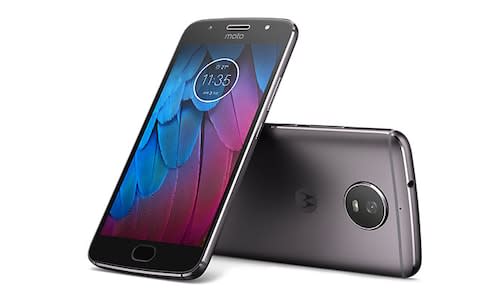
Screen size: 5.2 inches
Battery life: 19 hours talk time
Motorola's series of Android smartphones are some of the best value buys out there. This model is an upgrade on the hugely popular Moto G5, bringing a slightly larger screen at 5.2 inches. It includes an upgraded 3GB of RAM and 32GB of internal storage plus room for a dual SIM. It’s front and rear mounted cameras are reasonable, with a 16MP rear facing camera.
It has a sleek, aluminium body and runs on Android 7.0, keeping its menu and systems simple and in line with the original design. Other features include a fingerprint scanner and NFC to use apps like Android Pay
Pros: Best budget Android phone, 16MP camera, dual SIM
Cons: Weaker processor, limited storage
Nokia 3

Screen size: 5 inches
Battery life: 20 hours talk time
Cheap and cheerful, the new Nokia 3 is the return of the brand with the phones now made by HMD. The new Nokia 3 looks great with a funky design in four colours and a 5-inch HD screen.
It has reasonable battery life at 20 hours but it is not the most powerful phone around. It has 8MP front and back cameras and comes with the latest Android operating system. Nokia's entry level smartphone is one of the best budget smartphones this year and can be picked up for under £100 from Argos.
Pros: Decent look, incredibly cheap, solid battery life
Cons: Only 16GB storage, not that powerful
Samsung A3
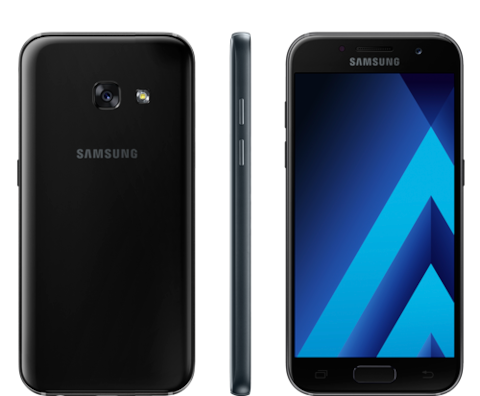
Screen size: 4.7 inches
Battery life: 17 hours talk time
Samsung has rebooted its A3 smartphone range for 2017, adding a power boost with a faster processor and upgrading its RAM from 1.5GB to 2GB, with 16GB of storage and the ability to add a 256GB SIM card. For a smaller smartphone it comes with a solid display, as Samsung’s super AMOLED screen offers great colours.
Samsung also improved the front camera on this model to 8MP, while the 13MP rear camera remains the same. The South Korean company has added a fingerprint scanner, bringing this Samsung up to scratch with many budget competitors, and the phone is said to be waterproof for up to 30 minutes (if you are brave enough to test). It comes in black, gold, peach and mist colours.
Pros: Screen quality, fingerprint scanner and waterproofing
Cons: Processor and storage matched by cheaper models
Under £500
OnePlus 5T

Screen size: 6-inch screen
Battery life: 36 hours
Upstart Chinese smartphone manufacturer OnePlus has made a real impact with its brand of cut-price premium smartphones. Its latest phone, the OnePlus 5T, is one of our favourite Android smartphones, and certainly the best you can buy for under £500.
It still comes in at reasonable £449 for the base model, which has 64GB of storage and a massive 6GB of RAM. making it lightning fast and able to run multiple tasks simultaneously. It also now features facial recognition and an edge-to-edge display, plenty of premium features for your money. It comes in Midnight Black.
Pros: Power and specs of a far more expensive phone, dual camera set up, facial recognition
Cons: Lacks extra storage, iPhone lookalike
Motorola Z2 Play
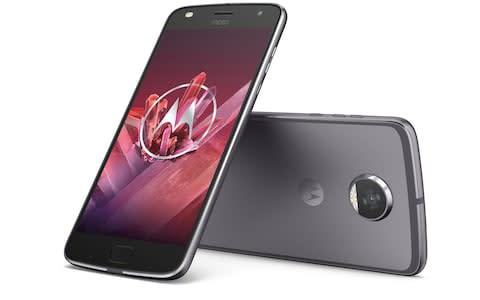
Screen size: 5.5-inch screen
Battery life: 30 hours
The Moto Z2 Play is fun, funky and unique, offering modular capabilities to let you change camera modules, gaming attachments or even add a speaker. It's one of the only modular smartphones, which means extra features can be clipped to the back magnetically. These include a powerful Hasselblad camera and a gamepad.
In terms of other stuff, it comes with a 12MP rear camera and a 5MP selfie camera, 64GB of internal storage plus up to 2TB more with a microSD card. It has fast charging, meaning you get eight hours power in 15 minutes
Pros: Good value handset, fast performance, innovative
Cons: Downgraded battery life, Moto Mods hike price significantly
Nokia 8

Screen size: 5.2-inch screen
Battery life: Day and a half
We praised the Nokia 8 smartphone for its battery life, clean Android operating system and unique camera. It is also the first smartphone which will allow you to take a "bothie", a selfie and a normal photo at the same time.
It comes with an all-day battery life, 64GB of internal storage and the option to add a 256GB microSD card to bulk this out. It maintains a headphone jack, unlike some more expensive models, and has a stylish aluminium body.
Pros: Nokia nostalgia, clean Android experience, unique-looking camera, solid battery life
Cons: Bothies will never happen, awkward fingerprint scanner, average camera performance
HTC U11
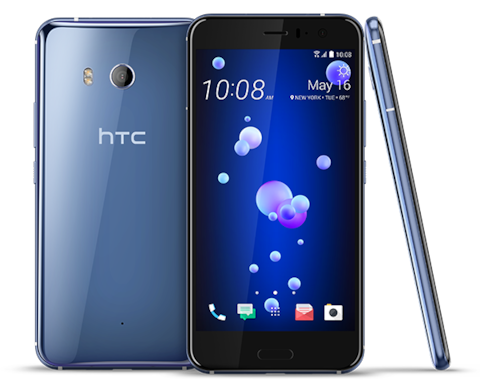
Screen size: 5.5 inches
Battery life: 24 hours talk time
The world's first "squeezable" smartphone, the HTC U11 brings new actions, allowing you to press the sides of the phone to engage features such as taking a selfie. It's a bit of a gimmick, but the whole package is actually one of the best Android smartphones this year.
The phone is also built for taking fantastic selfies, with a 16MP front camera to get the best out of your pictures. It has a gorgeous glass finish and comes in a range of bold colours to stand out from the crowd. It also has 2TB of expandable storage to keep all your snaps.
Pros: Fast performance, selfie camera, colourful look
Cons: Squeezing is a gimmick
Premium Android phones
Samsung Galaxy S8
Screen size: 5.8 inches
Battery life: 20 hours talk time
The Samsung Galaxy S8 is a beautiful device. It has an all round Edge Display, which means the phone screen slides seamlessly to the sides of the phone. It also has a headphone jack, unlike its main rivals from Apple. It is water and dust resistant and features 64GB of internal storage.
The S8 also has cool features from the standard fingerprint scanner to iris and facial recognition, and has brought in the Bixby virtual assistant, although on launch this did not feature voice control. While it raised the bar on smartphones and is probably the best Android phone you can buy, you will have to be able to part with some serious money to enjoy it.
Pros: Incredible performance, screen quality, beautiful design
Cons: Massive price tag, highly breakable, lack of Bixby voice control
Google Pixel 2 XL
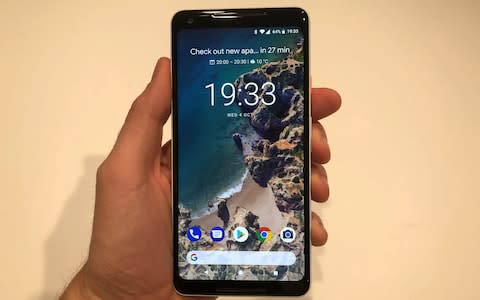
Screen size: 6 inches
Battery life: All day
The Google Pixel 2 XL is the tech giant's latest smartphone and it brings with it some major steps forward. It has a larger screen that covers most of the front of the screen, a rear fingerprint sensor and upgrades its rear dual camera - easily one of the best smartphone camera's out there with a 12.3MP lens.
It has a funky design and works with Google's Assistant AI to learn about how you use your phone and can respond to voice commands. It can also be used to integrate with Google's Daydream virtual reality platform.
Pros: Great integration of Android with Google services, fantastic camera, decent battery life
Cons: Design of smaller Pixel is dated, no headphone jack, expensive
Samsung Galaxy Note 8
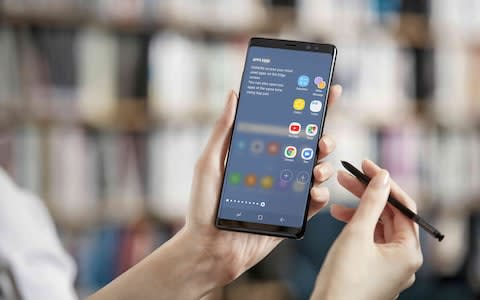
Screen size: 6.3 inches
Battery life: All day
Samsung's Galaxy Note 8 is a powerhouse of a phone with a premium price. It comes with a massive 6GB of RAM inside, enough to plug it in and use it like a mini-computer. It comes with a stylus pen for taking notes on the screen, and has the Bixby virtual assistant to take voice commands.
It has a 6.3-inch screen making it one of the largest Phablets (phone/tablets) out there. But it comes with a premium price of £869.
Pros: Gorgeous screen and design, brilliant camera, speedy
Cons: Price, questionable value of S-Pen, everyone will hilariously ask you if it explodes
Best technology you can buy grid
The Telegraph makes a small amount of money by adding affiliate links to products mentioned in this article, however all products are picked independently by our journalists.
